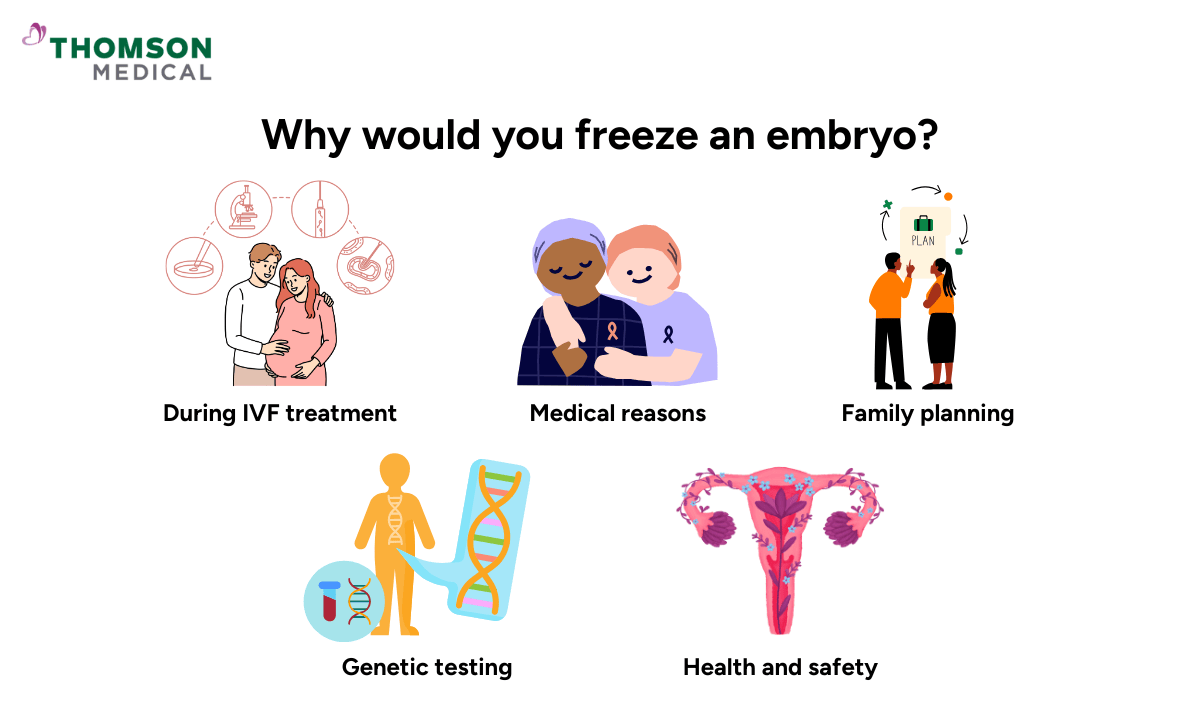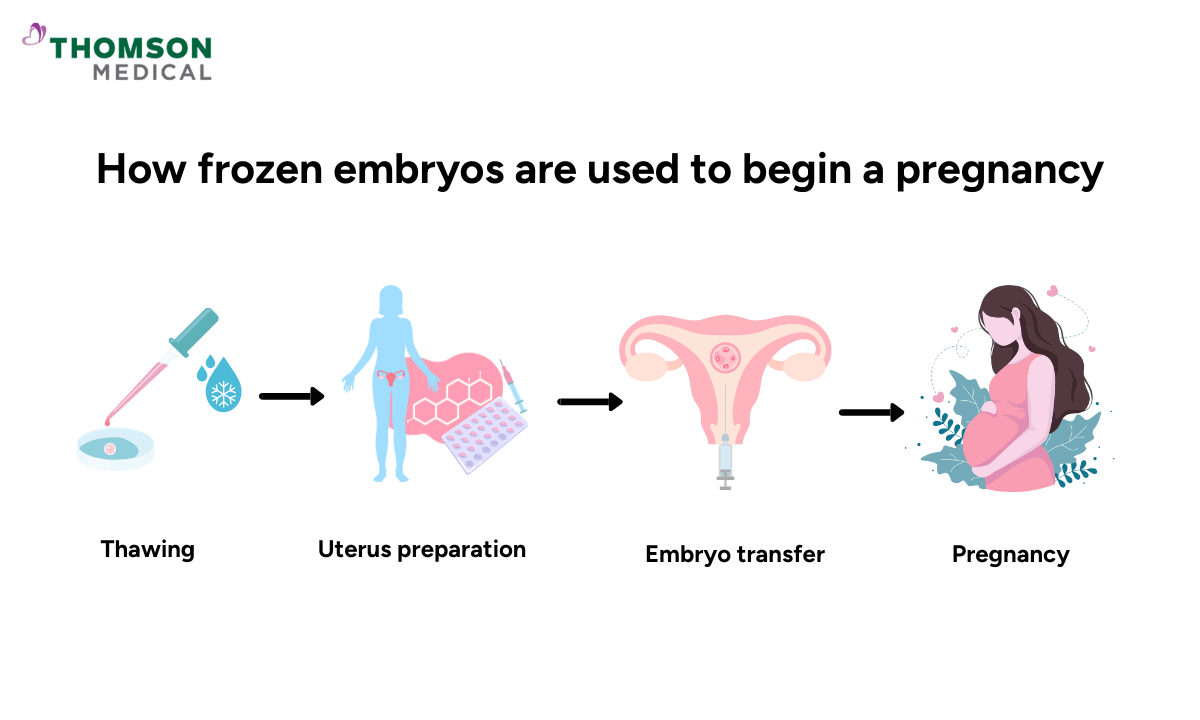Having children is a deeply personal choice, and for many, fertility preservation offers a way to align this choice with life's unpredictable timeline. Health issues, career paths, or simply wanting more time to decide are all common reasons people explore fertility preservation.
One of the most reliable ways to do that today is through embryo freezing, sometimes called embryo cryopreservation. This method allows embryos created in a lab to be stored safely for future use. For many, it’s both a scientific achievement and an emotional safety net. It keeps the door open to parenthood when the time feels right.
What is embryo freezing?
Embryo freezing is a fertility preservation technique commonly used in in vitro fertilisation (IVF) treatment. It involves preserving embryos in a lab by storing them safely at very low temperatures until they're needed for pregnancy.
The process starts when a woman's eggs are collected and fertilised with sperm in a lab. Once the eggs and sperm combine, they form embryos (the earliest stage of a developing baby). These embryos are then frozen using a technique called vitrification, which means ultra-rapid freezing. This method prevents ice crystals from forming inside the cells, protecting them from damage.
Frozen embryos are stored in tanks filled with liquid nitrogen at around -196°C. All biological activity stops at this temperature. This means the embryos can stay healthy and usable for many years. In most cases, embryos stay viable for 10-20 years, with some reports of successful pregnancy indicating they can remain viable even longer under optimal conditions.
Why would you freeze an embryo?

There are many reasons someone might choose to freeze embryos. The decision often depends on medical needs, timing, or family planning goals.
During In vitro fertilisation (IVF) treatment:
In many IVF cycles, doctors create more embryos than can be transferred in one attempt. Instead of discarding the remaining embryos, they are frozen for future use. This gives couples another opportunity for pregnancy without having to start a new IVF cycle from scratch.
Medical reasons:
Patients who are about to begin cancer treatments such as chemotherapy or radiotherapy may choose to freeze embryos beforehand, as these treatments can affect fertility. Doing so helps preserve the possibility of having a biological child in future.
Women who need ovarian surgery or have conditions like endometriosis (a condition where tissue similar to the uterus lining grows outside the uterus) may also benefit from freezing embryos as a precaution.
Family planning:
Some couples or individuals choose to delay pregnancy but still want to preserve younger, healthier embryos through fertility preservation. This option allows them to focus on other priorities now and return to treatment later when they are ready.
Genetic testing:
Before transfer, embryos can be tested for genetic conditions through Preimplantation Genetic Testing (PGT). Freezing of embryos gives time to complete the testing and carefully plan the next steps.
Health and safety:
Sometimes, the uterus may not be ready for an embryo transfer. If the uterine lining isn’t thick enough, doctors might recommend freezing the embryos and waiting until conditions improve to increase the chance of successful implantation.
If you're considering embryo freezing – whether due to upcoming medical treatment, IVF planning, or personal choice – speaking with a specialist can help you understand your options and timeline. Request an appointment with a fertility specialist at Thomson Medical to discuss your preservation options.
What are the differences between egg freezing and embryo freezing?
Egg freezing and embryo freezing are both proven ways to preserve fertility, but they work at different points in the process. The choice often depends on personal circumstances, relationship status, and future plans for pregnancy.
Feature | Egg freezing | Embryo freezing |
When it happens | Eggs are collected and frozen before fertilisation | Eggs are fertilised with sperm first, and the resulting embryos are frozen |
Need for sperm | Not required at the time of freezing. Sperm can be used later when ready to fertilise | Required immediately for fertilisation before freezing |
Success rate | Slightly lower, as eggs are more sensitive to freezing and thawing | Generally higher success rate, since embryos are more stable after vitrification |
Flexibility | Better for a single women who want to decide on a partner/donor later | Better for couple or single women who have already selected a sperm donor |
When ready to use | Eggs must be thawed, fertilised, and developed into embryos before transfer | Embryos can be thawed and transferred directly into the uterus |
Both options are safe and effective. Your fertility specialist can help you decide which approach fits your situation best.
Our fertility specialists
Loading...
How does the process work?
Embryo freezing procedures follow several carefully planned steps. Each stage is carefully monitored to protect egg and embryo quality.
Ovarian stimulation:
Hormone injections encourage the ovaries to produce several mature eggs instead of just one. This step takes 10-12 days. Your doctor monitors progress through ultrasound scans and blood tests.
Egg retrieval:
When the eggs are ready, they are collected in a short procedure. A fine needle, guided by ultrasound, is used to remove the eggs from the ovaries. The process takes about 15-30 minutes. It's done under sedation (a light sleep state) or general anaesthesia, so there's no pain.
Fertilisation:
The eggs are combined with sperm in the lab using assisted reproduction techniques (ART). Fertilisation can happen naturally in a lab dish, or the embryologist may use Intracytoplasmic Sperm Injection (ICSI), where a single sperm is injected directly into an egg.
Embryo development:
The fertilised eggs develop in embryo culture for 3-5 days. During this time, the embryologist watches their growth and checks their quality. By day five or six, the embryos reach the blastocyst stage (a more developed stage with over 200 cells), which is ideal for freezing.
Embryo selection:
The healthiest embryos are selected for freezing. Others may be used for immediate transfer if desired.
Freezing (vitrification):
The chosen embryos are rapidly frozen with a cryoprotective agent (special liquids that protect cells from damage). This stops ice crystals from forming, which could harm the cells. The vitrification method gives embryos a survival rate of more than 90% after thawing.
Storage:
Finally, the frozen embryos are stored in liquid nitrogen tanks. They’re monitored regularly to ensure temperature stability and safety. Embryos can remain frozen for many years without losing their quality.
The entire process is carefully managed by experienced specialists. You'll be informed at every stage, and we'll make sure you feel comfortable and supported throughout.
How frozen embryos are used to begin a pregnancy?

When you're ready to try for pregnancy, the process begins with a frozen embryo transfer. The frozen embryos are carefully thawed in a controlled lab. Once the embryos are thawed and confirmed viable, the next step is to prepare the uterus for implantation. The patient usually takes hormones such as oestrogen and progesterone to help thicken the lining of the womb. This is to ensure that when an embryo is placed inside, it has the best possible chance to attach and grow.
The actual transfer involves using a flexible tube called a catheter to place the embryo directly into your uterus. After the transfer, you can resume normal activities while waiting to see if implantation occurs.
If the embryo successfully attaches to the uterine wall, pregnancy begins and progresses naturally, just like in a typical conception. The success rate depends on the woman’s age when the eggs were retrieved, as younger eggs generally produce stronger embryos with higher chances of implantation.
How to prepare for embryo freezing?
Before starting the process, you may go through a few important steps to ensure the best possible outcome.
Medical evaluation:
This includes hormone testing, ultrasound examinations, and a semen analysis if a partner is involved.
Lifestyle adjustments:
Stop smoking, avoid alcohol, and eat a balanced diet. Maintaining a healthy weight and taking folic acid (400-800 mcg daily) can also improve fertility.
Counselling:
Many clinics offer discussions on storage duration, legal rights, and what happens to embryos in case of separation or death. This helps you make informed and comfortable decisions before treatment.
What are the benefits and risks of embryo freezing?
Modern freezing methods are very safe and effective. Still, like any medical procedure, embryo freezing has benefits and a few potential risks to be aware of.
Benefits of embryo freezing
Knowing the benefits helps you see why many individuals and couples choose to freeze their embryos as part of their fertility plan:
Preserves fertility for future use by safely storing embryos until you're ready
Offers flexibility in planning when to start or grow your family
Reduces the need for another full IVF cycle in the future
Gives time for genetic testing before transfer
Improves safety by allowing transfers only when the body is in the best condition
While the advantages are clear, it's still important to understand that every medical procedure carries some level of risk.
Risks of embryo freezing
While the procedure is considered safe, understanding the possible risks allows you to prepare better and make informed choices:
Most risks come from egg retrieval, which can rarely cause infection, bleeding, or minor injury to nearby organs
Some people may develop ovarian hyperstimulation syndrome (OHSS) when the ovaries react strongly to medication. This causes the ovaries to become swollen and painful
Freezing and thawing are safe with vitrification, but not every embryo will survive or implant successfully
Even though these risks exist, serious problems are uncommon. With proper monitoring and modern freezing methods, the overall safety and success rates remain high.
If you’re thinking about freezing your embryos, it’s natural to want clarity on both the benefits and risks. Request an appointment with Thomson Medical to consult our fertility specialists, who can walk you through the process, explain what to expect, and help you make confident, informed decisions about your fertility future.
FAQ
Is freezing embryos a good idea?
Yes. It's especially helpful for people going through IVF or those who may face fertility decline using assisted reproductive technologies (ART). It offers a reliable backup plan for future pregnancies.
How is embryo freezing done?
It involves IVF to create embryos, growing them in culture, freezing through vitrification, and storing them in liquid nitrogen.
Is a frozen embryo considered a baby?
Medically, no. A frozen embryo is a cluster of cells with the potential to develop into a baby if implanted. Views on this vary among cultures and beliefs.
Is freezing embryos painful?
The freezing process isn’t painful. Egg retrieval may cause mild discomfort, but it’s done under sedation to ensure comfort.
How long does embryo freezing take?
From stimulation to freezing, the process usually takes two to three weeks.
Who is a good candidate for embryo freezing?
People undergoing IVF, women facing medical treatments that affect fertility, couples who wish to delay pregnancy, or those who want to test embryos for genetic conditions.
The information provided is intended for general guidance only and should not be considered medical advice. For personalised recommendations and tailored advice based on your unique situations, please consult a specialist at Thomson Medical. Request an appointment with Thomson Medical today.
